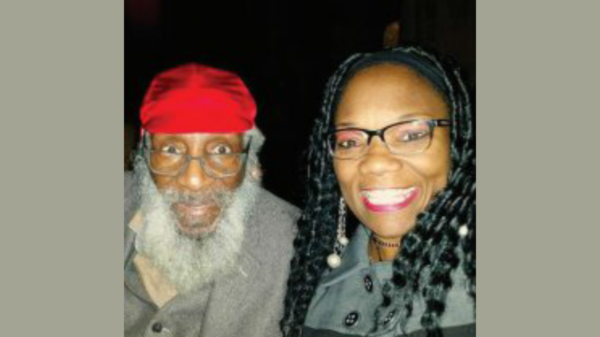By Dianne Solis

Reginald Hurd looks to the white arches of the Margaret Hunt Hill Bridge over the Trinity River as he stands in a West Dallas minipark named for his grandmother Helen C. Emory.
Squinting into the sunlight, Hurd pointed to the bridge and said, “That’s why this all started.”
Nearby, a bulldozer cleared ground for new homes not far from a Osage orange tree, a stately hardwood where Hurd once crashed his bicycle as a boy. His grandparents lived down the street, he said, pointing to an area of old one-story houses and new two-story townhouses.
Hurd, 61, wants to stabilize the neighborhood of his grandparents. Cecil and Helen Emory ran a grocery store, an essential business for what was then a mostly Black community.
The efforts of Hurd and community advocates like Lottie McKnight-Calhoun and Paula Hutchison to preserve the old neighborhood illuminate the obstacles.
Hurd tried to preserve the land where an old segregated school stood, but he was told it was too late.
He owned three houses but had to tear down one that was beyond repair. He maintains the other two as potential rentals in the neighborhood, though they are now empty. He refuses to sell to developers who might build pricey townhouses, though he knows he could probably make more money by selling.
Today, the neighborhood, Gilbert-Emory, carries the surname of his grandparents. Once it was simply called the Frederick Douglass community, after the segregated school that stood in the center of the neighborhood.
/cloudfront-us-east-1.images.arcpublishing.com/dmn/OUPXA47ALFFONKK4FTY5TF4CAM.jpg)
Hurd wanted to develop an expansive park at the former school site. But when he tried, he learned the land was about to be sold to a private developer.
“It was a wonderful idea,” said Hurd’s 83-year-old mother, Helen M. Hurd, daughter of the grocers, one February afternoon. She sighed sadly at her son’s attempt to preserve Black history.
She grew up not far from the school, on Muncie Avenue. She moved to southern Dallas in the early 1970s. But her mother, Helen C. Emory, stayed in the neighborhood until her death in 1993, as did other family members.
Emmanuel Glover and Sarah Ashitey moved into a $400,000 new townhouse in Gilbert-Emory at the outset of the COVID-19 pandemic in 2020.
WATCH: A Black neighborhood in West Dallas is disappearing as new townhomes rise

They loved their modern home and liked the mural scene in the nearby artist enclave across Sylvan Avenue. Both have medical backgrounds and are Black. Glover is an immigrant from Ghana.
They had no idea that their new neighborhood was historically an African American settlement. When they found out, they were delighted. Now they’re active in the neighborhood association, working on issues including policing, traffic density and random trash-dumping by outsiders.
Glover is president of the neighborhood association. He says it’s important to record the neighborhood’s history, right down to what he calls “the last remnant of the area.”
“After hearing the story and understanding the history of the place, it was very, very heartbreaking,” he said. “Gentrification is difficult to watch, especially if the people affected cannot do anything about it.”
Glover hopes to find solutions to stabilize the neighborhood as housing prices and property taxes escalate. That includes resources that the city of Dallas can initiate, such as a fund to help residents with property taxes.
“The city should be more proactive about providing resources to low-income communities to rejuvenate or revitalize their communities,” Glover said. “And that shouldn’t be branded as gentrification.”
Hurd’s two rental properties stand near Sylvan Avenue, across the street from a bustling cove of artists studios in industrial warehouses rebranded the Tin District by developers. One of the houses is still in good shape, he said. The foundation of the other sits on jacks to allow workers ease in making repairs with new lumber. A water heater sits on the front porch near windows flecked with old green paint.
Hurd, who lived in Gilbert-Emory as a small child and returned often to visit his grandparents, said his goal is to maintain “some of the old integrity of the neighborhood.”
“I’m not an investor that just has deep pockets,” he said. “That’s not it. I’m just trying to make something that’s going to be sustainable, you know.”
Hurd said he’s conflicted by what he sees in West Dallas. He likes the new dining scene and eats at the restaurants at Trinity Groves. More housing is being developed close to downtown, too.
“You see the freshness and the newness of everything, but it’s just pushing a lot of individuals who don’t have the resources out,” he said.
Hurd loved to eat at the old restaurants on Singleton Boulevard, too, including the yellow and red Dog House for wieners and Wimpy’s for hamburgers and a concoction called a “knockout” that was part ice cream and part snow cone. Wimpy’s still operates, but the Dog House has closed.
He remembers his grandmother Helen Emory going to City Hall to fight for paved streets and sidewalks, because she was fed up seeing kids playing in the mud. One of his first jobs was as a lifeguard at a nearby recreation center.
“So this is my neighborhood, basically. Even though I no longer live here, it’s still my neighborhood,” Hurd said.
Hurd’s contractor, Norris Taylor, said it’s hard to slow gentrification, but he was encouraged that Hurd was remodeling his house.
Townhouses in Gilbert-Emory priced at $600,000-plus are out of the price range for those who once lived there. “We can’t afford them,” said Taylor, motioning to fresh construction down the street.
“The well-to-do white people or Hispanic people can afford it,” Taylor said. “It’s frustrating, but we are not giving up.”
Here, at least on this patch of clay-rich dirt, there are green shoots of renewal — of Black renewal.
This article was reported and edited cooperatively by The Dallas Morning News, the Dallas Free Press and KERA, which participate in the Dallas Media Collaborative, a group of local news outlets, universities and nonprofits focused on covering affordable housing with a solutions-oriented approach.
This story, originally published in The Dallas Morning News, is reprinted as part of a collaborative partnership between The Dallas Morning News and Texas Metro News. The partnership seeks to boost coverage of Dallas’ communities of color, particularly in southern Dallas- at the bottom.









